Sunday 5 March 2006
Puerto Natales (CL) - El Calafate
(AR): 230 km
We rise early,
as we have a bus to catch to take us to El Calafate in Argentina. The bus leaves
at 8.30 and we have to check in half an hour before at the bus company's office.
We are traveling with Cootra, which 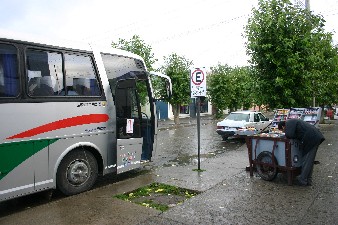 runs
a daily bus service with El Calafate via Rio Turbio. Before the bus
departs a man appears with a handcart selling candy and snacks. The bus driver
is an older guy, who is constantly talking into is radio and chatting with other
bus drivers in the area and god knows who else. He blows his horn whenever we
pass a road side chapel. On top of that he drives on the left side of the road
most of the time. On the rare occasion of on coming traffic he moves to the
right at, what seems to be, the last moment. After 30 km we reach the
international border with Argentina. At the border post we all have to out of
the bus and call on the Chilean border police. We get an exit stamp in our
passport. One of many on this trip - and that last from Chile. The we drive
another 3 km before we reach Argentine immigration. On lady on our bus did not
get a stamp from the Chileans and that is a major problem. She has to back,
together with the bus driver to get one.
At the Argentine border post we are reminded of the 1982 Falklands war. A huge
signs says: "Las
Malvinas son Argentinas" (The Falklands are Argentine). We continue
non-stop via good and not so good roads our journey through the
endless Patagonian pampa's. There is very little traffic an here and there some
sheep. The emptiness and the sheer space are impressive. Weather was bad in
Chile, but on the Argentinean side of the mountains it is much better. Even the
sun starts to shine. runs
a daily bus service with El Calafate via Rio Turbio. Before the bus
departs a man appears with a handcart selling candy and snacks. The bus driver
is an older guy, who is constantly talking into is radio and chatting with other
bus drivers in the area and god knows who else. He blows his horn whenever we
pass a road side chapel. On top of that he drives on the left side of the road
most of the time. On the rare occasion of on coming traffic he moves to the
right at, what seems to be, the last moment. After 30 km we reach the
international border with Argentina. At the border post we all have to out of
the bus and call on the Chilean border police. We get an exit stamp in our
passport. One of many on this trip - and that last from Chile. The we drive
another 3 km before we reach Argentine immigration. On lady on our bus did not
get a stamp from the Chileans and that is a major problem. She has to back,
together with the bus driver to get one.
At the Argentine border post we are reminded of the 1982 Falklands war. A huge
signs says: "Las
Malvinas son Argentinas" (The Falklands are Argentine). We continue
non-stop via good and not so good roads our journey through the
endless Patagonian pampa's. There is very little traffic an here and there some
sheep. The emptiness and the sheer space are impressive. Weather was bad in
Chile, but on the Argentinean side of the mountains it is much better. Even the
sun starts to shine.
In
El Calafate we arrive at 2pm. With a taxi we get to our hotel Frai
Toluca within minutes for only AR$ 3 (€0,80). The hotel is beautifully
perched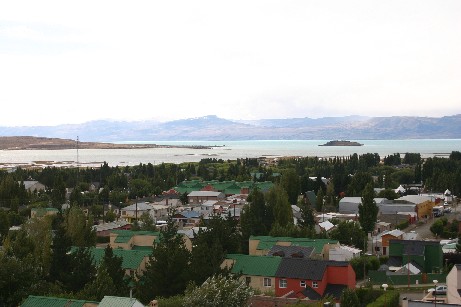 on a hill and all rooms have a view of the town and the Lago Argentino,
Argentina's largest lake. Calafate
is a strange place. It centred around the central boulevard, Libertador,
from where small side streets are running in an unplanned fashion down to Lago
Argentino or in the other direction up hill. El Calafate exists at the mercy of
tourists. All shops are geared to their needs: souvenirs, outdoor equipment and
tour operators. The tourists come here for the National
Park Los Glaciares, with its many glaciers. El Calafate is an hour's drive
from the southern sector of this Park with the famous glaciers Perito
Moreno and Upsala. In the afternoon we book a glacier mini-trekking on the Perito Moreno
for the next day (at
Hielo y Aventura)
and inquire at Fernandez
Campbell about the boat tour to Upsala glacier. The boat tour takes
all day and strangely enough can only be booked one day in advance. Later
we collect our car at Hertz
(Chevrolet Corsa).
on a hill and all rooms have a view of the town and the Lago Argentino,
Argentina's largest lake. Calafate
is a strange place. It centred around the central boulevard, Libertador,
from where small side streets are running in an unplanned fashion down to Lago
Argentino or in the other direction up hill. El Calafate exists at the mercy of
tourists. All shops are geared to their needs: souvenirs, outdoor equipment and
tour operators. The tourists come here for the National
Park Los Glaciares, with its many glaciers. El Calafate is an hour's drive
from the southern sector of this Park with the famous glaciers Perito
Moreno and Upsala. In the afternoon we book a glacier mini-trekking on the Perito Moreno
for the next day (at
Hielo y Aventura)
and inquire at Fernandez
Campbell about the boat tour to Upsala glacier. The boat tour takes
all day and strangely enough can only be booked one day in advance. Later
we collect our car at Hertz
(Chevrolet Corsa).
We buy a mate
mug. Mate is
a tea like broth, that is drawn from dried Yerba-leaves that grow on the
evergreen Ilex
Paraguayensis-tree.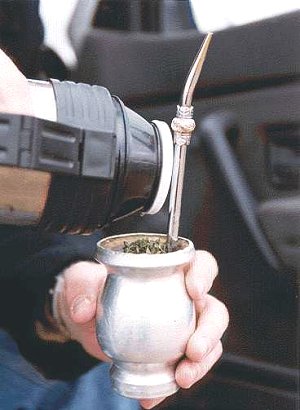 Argentineans do not seem to get enough of it and always some of them sipping
from it. It is quite a ritual, taken very seriously indeed by
Argentineans. The mugs, called matecitos, are made of a hollowed-out gourd
of the Lagenaria
Vulgaris with a steel straw (bombilla) make good souvenirs. In
the supermarket we buy a box of Mate. We are curious to know what it
tastes like. The matecito has to be filled half with mate. Then you have pour
hot (but not boiling water) along the straw into the Matecito, so that the mate
gets wet from the bottom up. Throw in a couple of tea spoons of sugar for good
measure - even if you have not a sweet tooth. Then you have to carefully suck on
the bombilla (not too hard - it is not a milkshake) and pass on the matecito the
person to your right. The water has to be topped up from time to time. This goes
on until the mate looses all its flavour. In café's and shops Mate-drinkers
(Materos) can fill up the thermo bottle with hot water for a nominal charge. And
the taste.... It is very bitter. Well, let's say it is an acquired taste.
Argentineans do not seem to get enough of it and always some of them sipping
from it. It is quite a ritual, taken very seriously indeed by
Argentineans. The mugs, called matecitos, are made of a hollowed-out gourd
of the Lagenaria
Vulgaris with a steel straw (bombilla) make good souvenirs. In
the supermarket we buy a box of Mate. We are curious to know what it
tastes like. The matecito has to be filled half with mate. Then you have pour
hot (but not boiling water) along the straw into the Matecito, so that the mate
gets wet from the bottom up. Throw in a couple of tea spoons of sugar for good
measure - even if you have not a sweet tooth. Then you have to carefully suck on
the bombilla (not too hard - it is not a milkshake) and pass on the matecito the
person to your right. The water has to be topped up from time to time. This goes
on until the mate looses all its flavour. In café's and shops Mate-drinkers
(Materos) can fill up the thermo bottle with hot water for a nominal charge. And
the taste.... It is very bitter. Well, let's say it is an acquired taste.
We go back to
the hotel and zap a bit with our tv. We are amazed by the number of football
channels. There are even channels - apparently not in possession of the live
broadcasting rights of the matches - that only show images of the
spectators, accompanied by a kind of radio report of the match itself. Later on
they show a compilation or just the goals. There is also a lot of foreign
football on tv, most of it from Europe. Not only Spanish, English and Italian,
but also Dutch football is followed closely here.
We have dinner
at the Michelangelo hotel. Fine food for relatively little money (AR$93 or €25
for a 3 course dinner for two, including wine). After dinner we head back to the
hotel.
Weather:
in Chile heavy rain, cold and 8 degrees. In Argentinia sunny, windy and 15
degrees.
Monday 6 March 2006
We drive out
of town in a westerly direction. It sunny and the thermometer goes up slowly
from 7 towards 15 degrees Celsius. As soon as we approach Los Glaciares National
Park the temperature suddenly drops again to 8. 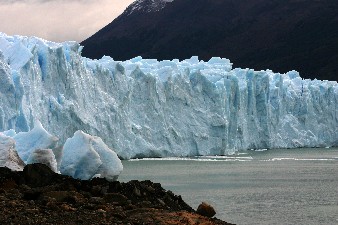 We drive to the dock of Hielo y
Aventura. At ten we board a small boat that takes us to the starting point
for our mini-trekking on the Perito Moreno glacier. To our dismay we meet again
with the boisterous group of Dutchmen we saw ten days earlier in our hotel in
Ushaia on Tierra del Fuego. We cross the
Brazo Rico, a branch off the Lago Argentino. On the other side we get
instructions and an introduction the natural wonders of the Perito Moreno
glacier. The glacier is in balance, as it is called. It is not growing, but
steadily advancing at the pace of a couple of metres a day. Glaciers snout has
now reached the other side of the lake and now cuts off the Brazo Rico from the
rest of the Lago Argentino. The Brazo's water level is already 7 metres above
the lake's and the glacial dam is expected collapes under the water pressure,
after which the whole process will start again. [This eventually happens on
13 March. It is broadcasted live on TV
We drive to the dock of Hielo y
Aventura. At ten we board a small boat that takes us to the starting point
for our mini-trekking on the Perito Moreno glacier. To our dismay we meet again
with the boisterous group of Dutchmen we saw ten days earlier in our hotel in
Ushaia on Tierra del Fuego. We cross the
Brazo Rico, a branch off the Lago Argentino. On the other side we get
instructions and an introduction the natural wonders of the Perito Moreno
glacier. The glacier is in balance, as it is called. It is not growing, but
steadily advancing at the pace of a couple of metres a day. Glaciers snout has
now reached the other side of the lake and now cuts off the Brazo Rico from the
rest of the Lago Argentino. The Brazo's water level is already 7 metres above
the lake's and the glacial dam is expected collapes under the water pressure,
after which the whole process will start again. [This eventually happens on
13 March. It is broadcasted live on TV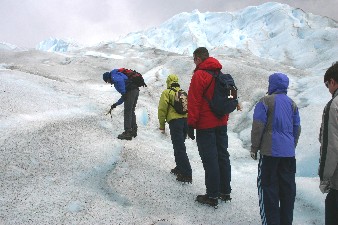 ].
The Perito Moreno is being fed from the South Patagonian Icefield, an are of ice
measuring over 22.000 km². During the introduction on the lake's shore an
enormous thundering sound suddenly roars. It sounds like lightning. It is in
fact a large chunk of ice breaking of and causing a huge wave in the lake.
We walk towards the foot of the glacier and our boots are fitted with crampons.
We then follow the guides in a single file. This way you avoid falling into a crevasse
or hole in the ice. We see several crevasses and holes and the likes. It is a
pleasant climb and not really demanding. At the end of the two hour walk we are
treated to a glass of whisky on the rocks with age old glacial ice. ].
The Perito Moreno is being fed from the South Patagonian Icefield, an are of ice
measuring over 22.000 km². During the introduction on the lake's shore an
enormous thundering sound suddenly roars. It sounds like lightning. It is in
fact a large chunk of ice breaking of and causing a huge wave in the lake.
We walk towards the foot of the glacier and our boots are fitted with crampons.
We then follow the guides in a single file. This way you avoid falling into a crevasse
or hole in the ice. We see several crevasses and holes and the likes. It is a
pleasant climb and not really demanding. At the end of the two hour walk we are
treated to a glass of whisky on the rocks with age old glacial ice.
We
descend from the glacier and return to a refugio or hut. We eat our boxed lunch
there and wait for the boat to take us back. Meanwhile we watch the glacier
shedding chunks of ice with load roars of thundering sounds. 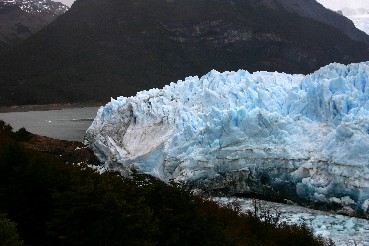 At 3pm we are back on the othr side. We then drive up to the panoramic balconies
to have look at the glacier from above. It is very busy out there.
At 3pm we are back on the othr side. We then drive up to the panoramic balconies
to have look at the glacier from above. It is very busy out there.
We drive back
to Calafate and bring our clothes to the laundry. We have to put it in crates.
The price is based on the number of filled crates. It will be ready tomorrow. We
have a beer at the side walk tables of Casimiro Bigua before we return to the
hotel. At night we eat at La Pura
Vida. A relaxed sympathetic eating place, lounge bar and restaurant. It is a
fair bit away from the centre on the Avenida Libertador . Good food, but rich
and the servings are very generous indeed.
Weather:
in Calafate sunny and 20 degrees. Near the glacier 12 degrees and some light
rain.
Tuesday 7 March 2006
We rise early
and by 7.15 we are on our way to Puerto
Banderas on Lago Argentino. It is about a 45 minutes' drive from El Calafate.
From there we are making a boat tour to the Upsala glacier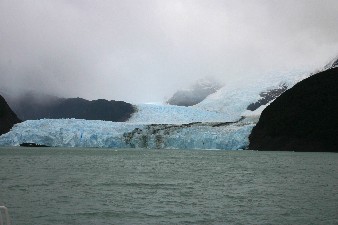 . We
are way too early and have to wait for half an hour before we can board Fernandez Campbell's
ship. It is a catamaran type vessel that is taking us through the branches of
the lake. First we "set sail" to the Spegazinni glacier. It rises 60
metres above the water. The glacier is not receding. On the contrary, it seems
to be growing. The glacier is 25 km long and has a surface measuring
66km². In it's natural setting the glacier looks very impressive. Next to it is
the Seco glacier, which is clearly receeding. Upstairs on the upper viewing
deck, it is rather cool and there is a strong freezing cold wind. The sight of
the blue coloured is is stunning. The ice turns blue because the oxigen has been
pressed out by the centuries long pressure of the ice above and has become
extremely compact. . We
are way too early and have to wait for half an hour before we can board Fernandez Campbell's
ship. It is a catamaran type vessel that is taking us through the branches of
the lake. First we "set sail" to the Spegazinni glacier. It rises 60
metres above the water. The glacier is not receding. On the contrary, it seems
to be growing. The glacier is 25 km long and has a surface measuring
66km². In it's natural setting the glacier looks very impressive. Next to it is
the Seco glacier, which is clearly receeding. Upstairs on the upper viewing
deck, it is rather cool and there is a strong freezing cold wind. The sight of
the blue coloured is is stunning. The ice turns blue because the oxigen has been
pressed out by the centuries long pressure of the ice above and has become
extremely compact. 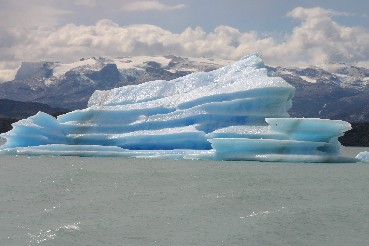 There also brown patches of ice. That colour comes from the dirt, that the
glacier has scrubbed of the rocks. After a good look at the glacier's snout we
sail on to Upsala glacier, the biggest glacier in Los Glaciares National Park.
This one is not as high as the others, but much wider. It has a surface of over
1,000 km². Every now and then some ice breaks off. We sail past numerous
gigantic icebergs moving with the current and the winds away from the glaciers.
After a short stay at Upsala we carry on to Onelli bay. Here we go off the ship
and escorted by a guide we walk through a protected forest (smoking not allowed)
we walk to Onelli lake, which is connected to Lago Argentino by a river. Three
glaciers (Onelli, Bolado, Agassiz) end up in Onelli lake and produce a large
number of icebergs that end up in one corner of the lake where they melt. It is
a fascinating sight
There also brown patches of ice. That colour comes from the dirt, that the
glacier has scrubbed of the rocks. After a good look at the glacier's snout we
sail on to Upsala glacier, the biggest glacier in Los Glaciares National Park.
This one is not as high as the others, but much wider. It has a surface of over
1,000 km². Every now and then some ice breaks off. We sail past numerous
gigantic icebergs moving with the current and the winds away from the glaciers.
After a short stay at Upsala we carry on to Onelli bay. Here we go off the ship
and escorted by a guide we walk through a protected forest (smoking not allowed)
we walk to Onelli lake, which is connected to Lago Argentino by a river. Three
glaciers (Onelli, Bolado, Agassiz) end up in Onelli lake and produce a large
number of icebergs that end up in one corner of the lake where they melt. It is
a fascinating sight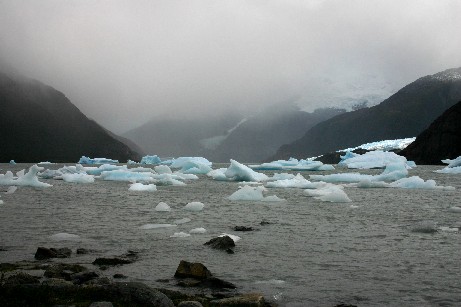 .
There is a strong and cold wind. The lake shows how difficult it is to estimate
distances in this kind of environment. Our guide tells us that Onelli glacier is
11 km away. It seems much less. We are allowed to roam around for an hour for
taking pictures. Fernandez Campbell's official photographers do that too. Their
pictures are for sale later on on board the ship. Back on board most of the
passengers fall vast asleep. After two and a half hours we are back in
port. We drive back to El Calafate over the empty roads and collect our laundry.
Two baskets for 10 pesos each. All that laundry done (neatly folded, not ironed
though) for no more than six euros! .
There is a strong and cold wind. The lake shows how difficult it is to estimate
distances in this kind of environment. Our guide tells us that Onelli glacier is
11 km away. It seems much less. We are allowed to roam around for an hour for
taking pictures. Fernandez Campbell's official photographers do that too. Their
pictures are for sale later on on board the ship. Back on board most of the
passengers fall vast asleep. After two and a half hours we are back in
port. We drive back to El Calafate over the empty roads and collect our laundry.
Two baskets for 10 pesos each. All that laundry done (neatly folded, not ironed
though) for no more than six euros!
At night we
have dinner at Casimiro Bigua Parrilla. A tastefully decorated restaurant,
modern with friendly (and handsome) servers and good food and wine. A place you
would sooner expect in a big city. After dinner we climb up the hill towards our
hotel.
Weather: cold, 12
degrees max. Occasional rain.
Wednesday
8 March 2006
El Calafate - El Chalten: 215 km
After
breakfast we discover that our car has been damaged. Someone drove into its left
front side. Very annoying. We go to Hertz, where they advise us to report it to
the police. It seems we have no choice in the matter. At the police station our
statements are promptly taken by a young, courteous, helpful and handsome police
officer. Unfortunately is not too experienced, as two of his senior colleagues
have to make some improvements and I myself detect an error or two. What follows
next is a somewhat bizarre procedure. I have to go to provincial office where I
have to get a payment slip in order to pay a official levy. At that office there
is a man sitting behind a almost bare desk, doing nothing. I show a piece of
notepad paper which I was give by the policemen. Without saying a single
word the man gives me the payment slip. I have to take it to the Banco Santa Cruz
to pay the levy. That takes about an hour. There is an enormous queue. This is
due to a complex problem, which is being dealt with by the bank -
according to a poster in the bank. Then I have return to the police station to
collect the police declaration with the necessary stamps and seals.
Finally
we can get on our way to El
Chalten. When we turn off the provincial road RP-11 onto National Ruta 40,
our first thought is that we have taken the wrong turn. The road is in such bad
state. But they are working on it . A couple metres to the right we see the new
road being constructed. After some 40 km we get the chance to enjoy the freshly
laid out tarmac. 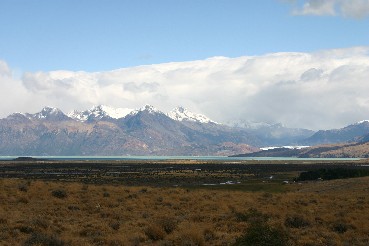 This
is a short lived pleasure, because only 20 km further down, it is dirt road or Ripio
again. At Hertz they emphasized that we were not allowed to drive faster
than 60 km/h on Ripio's. We are glad if we can make 40 km/h. Potholes, rocks and
wash board do not permit high speeds. The road remains bad and there are no
villages on the way. After more than an hour we see a little cottage that
doubles as a road house. It is in the middle of nowhere and we are served a
couple of warm pizza slices. In the front garden a young bull grazes peacefully
alongside a guanaco. An old man sits on the porch staring at them. We
continue our journey and get sight of Lago Viedma. A wonderful sight it is, with
the blue water against the backdrop of snow capped mountains. Meanwhile we are
driving on neat tarmac . We turn left onto the RP23 to El Chalten, which also
has perfect tarmac. Now it is another 90 km along the lake. In the far the snow
capped mountains emerge: the Cerro Torre and the Cerro FitzRoy. Beautiful photo
stops. Unfortunately the sealed road stops some 25 km before we get to El
Chaltén and we have make do with the usual rocks and potholes of the Ripio. In
the small town of El Chaltén we quickly find the youth hostel Condor de los
Andes, where we have booked a double room with private bath room. The owner
recommends a drive to the local waterfall. Advice that we follow promptly. The Chorillo del Salto is
small, but nice and easy to get to. In El Chaltén it is chilly, about 12
degrees. Later it cools down to 5. We have a home brew beer at the micro brewery
and eatery El
Bodegón and at night we eat out at Patagonic. The food is okay, but the
service by ageing hippy owner is dead slow. His parents are cooking in the
kitchen. We leave immediately after the main course and go to another restaurant
for coffe. This one is run by to guys, one of who speaks Dutch. He has lived and
worked in the Netherlands. Soon the conversation turns to football and the
upcoming World Cup, in which Argentina and the Netherlands will meet in the
first round. The guy follows his favourite teams in the Dutch football league
closely. Argentina's hopes these days are vested in Messi, a young player which
we saw in last years World Cup for under 20 year olds. Riquelme is one to watch
too. These guys are fan of Boca Juniors and Independiente, both from Buenos
Aires. This
is a short lived pleasure, because only 20 km further down, it is dirt road or Ripio
again. At Hertz they emphasized that we were not allowed to drive faster
than 60 km/h on Ripio's. We are glad if we can make 40 km/h. Potholes, rocks and
wash board do not permit high speeds. The road remains bad and there are no
villages on the way. After more than an hour we see a little cottage that
doubles as a road house. It is in the middle of nowhere and we are served a
couple of warm pizza slices. In the front garden a young bull grazes peacefully
alongside a guanaco. An old man sits on the porch staring at them. We
continue our journey and get sight of Lago Viedma. A wonderful sight it is, with
the blue water against the backdrop of snow capped mountains. Meanwhile we are
driving on neat tarmac . We turn left onto the RP23 to El Chalten, which also
has perfect tarmac. Now it is another 90 km along the lake. In the far the snow
capped mountains emerge: the Cerro Torre and the Cerro FitzRoy. Beautiful photo
stops. Unfortunately the sealed road stops some 25 km before we get to El
Chaltén and we have make do with the usual rocks and potholes of the Ripio. In
the small town of El Chaltén we quickly find the youth hostel Condor de los
Andes, where we have booked a double room with private bath room. The owner
recommends a drive to the local waterfall. Advice that we follow promptly. The Chorillo del Salto is
small, but nice and easy to get to. In El Chaltén it is chilly, about 12
degrees. Later it cools down to 5. We have a home brew beer at the micro brewery
and eatery El
Bodegón and at night we eat out at Patagonic. The food is okay, but the
service by ageing hippy owner is dead slow. His parents are cooking in the
kitchen. We leave immediately after the main course and go to another restaurant
for coffe. This one is run by to guys, one of who speaks Dutch. He has lived and
worked in the Netherlands. Soon the conversation turns to football and the
upcoming World Cup, in which Argentina and the Netherlands will meet in the
first round. The guy follows his favourite teams in the Dutch football league
closely. Argentina's hopes these days are vested in Messi, a young player which
we saw in last years World Cup for under 20 year olds. Riquelme is one to watch
too. These guys are fan of Boca Juniors and Independiente, both from Buenos
Aires.
We walk back
to the hostel and go to bed early. Tomorrow has another walk in store.
Weather:
some light rain. Strong and cold wind. Max. 13 degrees. In Chalten even colder.
|
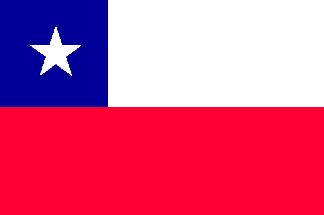
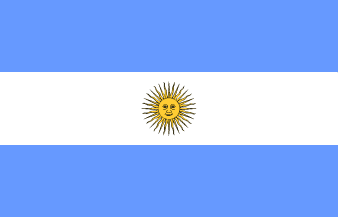
 Argentineans do not seem to get enough of it and always some of them sipping
from it. It is quite a ritual, taken very seriously indeed by
Argentineans. The mugs, called matecitos, are made of a hollowed-out gourd
of the Lagenaria
Vulgaris with a steel straw (bombilla) make good souvenirs.
Argentineans do not seem to get enough of it and always some of them sipping
from it. It is quite a ritual, taken very seriously indeed by
Argentineans. The mugs, called matecitos, are made of a hollowed-out gourd
of the Lagenaria
Vulgaris with a steel straw (bombilla) make good souvenirs.